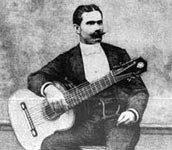The following is translated from the pertinent sections of “La Guitarra Malagueña-Cinco Siglos de Historia” by E. Rioja 1989. This information is probably found in one of his books but in this case the source is the catalogue of an exhibition of the same name. Musicologist Eusebio Rioja wrote the only book about the guitar makers of Granada back in 1976 and has established himself as an expert on the Spanish guitar especially with regards to the makers of Andalucia.
Antonio de Lorca Garcia
Antonio was born to Asensio (a carpenter) and Florencia in the Spanish city of Cartagena in 1798 and baptised in the parish church of Santa Maria. At the age of 20 he moved to Malaga where he was registered as living at number 13 Carretería street. He married Francisca Pino, became a widower early on but not before having five children: Dolores, Pilar, Encarnación, Antonio and Carolina. He died in 1870.
His reputation as a guitar maker must have been good and he seemed to have no economic problems. There are records of servants working at his home and a long list of journeymen in his workshop. Among them were: José María Torrens, José Salido, Antonio Pomar, and Salvador Castellón. In 1848 he was awarded a silver medal by the “Sociedad Económica de Amigos del País in an exhibition on the presentation of “a guitar with excellent voices”. This maker begins a dynasty which carries on with his son Antonio de Lorca Pino, his grandson Antonio de Lorca Ramirez and through Francisco Dominguez (guitar maker in the workshop of Lorca Pino) and his son José Dominguez still working today in Muro de San Julian street. (José Dominguez died in the 90’s and left no disciples)
Domingo Prat, and some of the labels on Lorca’s guitars, claim that the workshop was founded in 1803 but given his birthdate of 1798 that seems highly unlikely. In any case the relevance of this line of guitar makers is unquestionable, given the information above as well as the mention of Lorca in the following publications:
Francisco Bejarano, “Guitarrerías”
Sebastian Souvirón, “Historias del siglo XIX”
Manuel Blasco, “La Málaga de comienzos del siglo”
Antonio de Lorca Pino
This maker learned from his father and supervised Francisco Muñiz, Vicente Salido, Francisco Molina, the already mentioned Francisco Dominguez and of course his own son Antonio de Lorca Ramirez. Domingo Prat writes of Lorca Pino the following:
“Lorca Pino, within the world of guitars, guitar makers, and guitarists he moved in, knew how to make his workshop a meeting point and place of study and critique where Torres, (Julian) Arcas, and (Juan) Parga and many others often visited. We could say that among instruments and music the shavings fell down giving rise to multicoloured preludes. Lorca Pino was a distinguished player, a student of Parga who in 1893 dedicated to Lorca his Opus 10 Capricho sobre las murcianas, his first concert rhapsody. Juan Parga’s guitar that appears on the cover of his published works was built by Lorca, his guitarist disciple in 1889.”
Antonio de Lorca Ramirez
He continued the family tradition but increased production and included lower quality instruments in his offering.
A cd with one track on an original Lorca
A cd with duets on a Lorca copy

